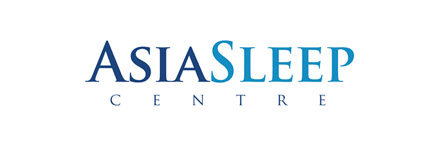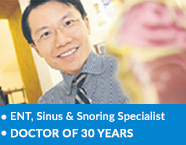Snoring, Sinus & ENT Specialist
- Dr Kenny Peter Pang
- Ear, Nose & Throat Consultant
- Otorhinolaryngologist
- MBBS MRCS(Edinburgh)(UK)
- FRCS(Edinburgh)(UK)
- FRCS(Ireland)(OTO)
- Masters Medicine (ORL)
- Founder, ASEAN Sleep Surgical Society
- Founding Member, International Surgical Sleep Society
- Member, American Academy Sleep Medicine
- Member, Singapore Sleep Society
- Member, World Sleep Society
- Board Member, Italian Sleep Disorders Board
- Member, British Association of Sleep Surgeons
- Member, European Academy of Sleep Medicine
Sinusitis is the inflammation/infection of 1 or more paranasal sinuses and occurs when there is obstruction of the normal sinus drainage mechanism. It is traditionally subdivided into:
- acute (symptoms lasting <3 weeks),
- subacute (symptoms lasting between 3 week to 3 months), and
- chronic (symptoms lasting > 3 months).
- Diseases that obstruct the drainage of the sinuses can result in a reduced ability of the paranasal sinuses to drain fluid out and function normally.
- The sinus ostia may become occluded, leading to mucosal congestion.
- The mucociliary transport system becomes impaired, leading to more stagnation of secretion and epithelial damage, followed by decreased oxygen tension and subsequent bacterial growth.
Symptoms
- nasal congestion,
- purulent nasal drainage,
- facial congestion and
- facial pain with headache.
Patients usually complain of yellowish green foul smelling discharge and nose blocked.
Facial pain would be according to the location of the sinus involved:
- maxillary sinus pain would be in the cheeks,
- frontal sinus pain would be in the forehead region,
- ethmoid would cause pain between the eyes or retro-orbital (behind the eyes) pain, and
- sphenoid would cause pain in the vertex of the head.
Clinical examination might reveal tender cheek bones or tender forehead region.
Flexible fibreoptic endoscopy would reveal swollen nasal turbinates, mucopus within the middle or superior meatus streaking backwards into the nasopharynx. Often the natural sinus ostia would be obstructed and clogged with swelling of the nasal mucosa, pus or nasal polyps.
Acute sinusitis is usually bacterial in origin. An upper respiratory tract infection (flu, common cold) or severe allergic rhinitis leading to obstruction of the ostia (openings of the sinuses) and stasis (stagnation) of drainage often precedes it. Haemophilus influenzae, Moraxella catarrhalis and Streptococcus pneumoniae are the organisms most commonly found in acute sinusitis. However, in chronic sinusitis, the infecting organisms are variable, and a higher incidence of anaerobic organisms are noted (eg, Bacteroides, Peptostreptococcus, and Fusobacterium species).
Acute or chronic sinusitis is a clinical diagnosis based on history and physical examination. In general, no imaging studies are required unless the patient requires surgery, pre-operative CT (computer tomography) scan of the sinuses are performed. Coronal sinus CT is the imaging study of choice in the evaluation of patients with sinusitis. The CT scan is done to delineate sinus anatomy, disease extent (which sinuses to operate on) and anatomical variants/bony landmarks. Plain sinus X-rays have limited role, but may be useful for air fluid levels.
Serious complications of acute and chronic are very rare; they include meningitis, and orbital abscesses. Prognosis is usually very good when detected early and drained surgically.
Management of acute is chiefly medication and supportive therapy. Medication includes culture directed antibiotic therapy (example penicillin based antibiotic), nasal decongestants, and topical oxymetazoline. Surgical intervention would be an antral wash out for the maxillary sinus. For chronic, medical therapy is often considered an adjunct to surgical treatment and is directed toward controlling predisposing factors, treating concomitant infections, reducing edema of sinus tissues, and facilitating the drainage of sinus secretions.
Advances in endoscopic technology and better understanding of the importance of the ostiomeatal complex (in the middle meatal region, lateral to the middle turbinate) in the pathophysiology have led to the establishment of functional endoscopic sinus surgery (FESS) as the surgical procedure of choice for the treatment of chronic sinus. FESS facilitates the removal of disease, restores adequate aeration and drainage of the sinuses by establishing patency of the ostiomeatal complex, and causes less damage to normal nasal functioning. FESS is successful in restoring sinus health, with complete or at least moderate relief of symptoms in 80-90% of patients.






